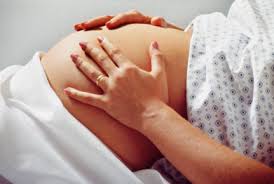March 13th, 2011 by Linda Burke-Galloway, M.D. in Better Health Network, Health Tips
No Comments »

 I came across an article the other day about paint and pregnancy. Yes, that paint — the kind that you put on a canvas or slap on your walls. Did you know that paint is made of pigment particles in a liquid base called a medium? Oil paints are thinned or cleaned with paint thinners. Latex paints are thinned or cleaned with water. Most paint that’s used in the home is latex.
I came across an article the other day about paint and pregnancy. Yes, that paint — the kind that you put on a canvas or slap on your walls. Did you know that paint is made of pigment particles in a liquid base called a medium? Oil paints are thinned or cleaned with paint thinners. Latex paints are thinned or cleaned with water. Most paint that’s used in the home is latex.
Can environmental forces affected pregnancy? The short answer is “yes,” according to the Organization of Teratology Information Specialists (OTIS), whose mission is to study malformations of the unborn.
Regarding paint and pregnancy, the amount of exposure is important. A one-time household exposure causes fewer problems than ongoing exposure through a work setting. And there have been medical studies documenting babies being born with problems if their mothers abused toluene-containing paint in order to “get high.” Toluene is a paint thinner that can cause low birth weight, premature labor, small head size, and developmental delays. Again, these problems only occur if pregnant women have been exposed to very high levels of toluene — much higher levels than exposure based on a hobby or a professional painter.
According to OTIS, working as a painter doesn’t pose concrete risks to the pregnancy. However, any reduction in chemical exposure is always a good thing. Read more »
*This blog post was originally published at Dr. Linda Burke-Galloway*
March 3rd, 2011 by Linda Burke-Galloway, M.D. in Better Health Network, Health Tips
No Comments »

 Having a baby can be a beautiful thing until something goes wrong. The tragedy is that many high-risk conditions can be managed appropriately if the patient is cooperative and the healthcare provider is competent and well trained. Unfortunately, almost 600 pregnant women die in the U.S. each year from complications and the most common complication is significant blood loss after birth or postpartum hemorrhage (PPH).
Having a baby can be a beautiful thing until something goes wrong. The tragedy is that many high-risk conditions can be managed appropriately if the patient is cooperative and the healthcare provider is competent and well trained. Unfortunately, almost 600 pregnant women die in the U.S. each year from complications and the most common complication is significant blood loss after birth or postpartum hemorrhage (PPH).
PPH occurs when there is a blood loss of 500 cc or greater for a vaginal delivery and 1,000 cc after a cesarean section (C-section). Or, if you were admitted with a hemoglobin of 12 and it drops by ten points to 11, there should be a high index of suspicion for PPH as well. Therefore, if you feel lightheaded or dizzy, have palpitations or an increased heart rate after delivering a baby, inform the hospital staff immediately.
The most common cause of PPH is uterine atony or lack of contractions after the baby is delivered. Any pregnant condition that stretches the uterus significantly — such as having twins or a higher gestation, excess amniotic fluid (aka polyhydramnios), a prolonged induction of labor (greater than 24 hours) — increases the risk of PPH. Retained products of conception, such as the placenta, also places the patient at risk for developing PPH.
Other risk factors for PPH include:
- Women with a known placenta previa
- African-American women
- Hypertension or preeclampsia
- Mothers with infants weighing greater than 8.8 pounds (or 4,000 grams)
- Mothers with greater than seven children
- Women with a history of hemophilia
If you have any of the risk factors listed above, please be proactive and discuss the possibility of a PPH with your healthcare provider. Read more »
*This blog post was originally published at Dr. Linda Burke-Galloway*
February 24th, 2011 by Linda Burke-Galloway, M.D. in Health Tips, Research
No Comments »

 Birth defects, particularly those of the blood vessels, account for the majority of infant deaths, especially after the first week of life. Congenital heart disease (CHD) — meaning defects of the heart — is responsible for one-third of deaths between birth and the first year of life. Therefore, the diagnosis of CHD is critical in order to plan life-saving treatments, such as the proper place for the delivery, the type of delivery, and its timing. If it’s known in advance that an unborn baby has a heart problem and is delivered in a hospital that provides special care, its survival and future health will increase dramatically.
Birth defects, particularly those of the blood vessels, account for the majority of infant deaths, especially after the first week of life. Congenital heart disease (CHD) — meaning defects of the heart — is responsible for one-third of deaths between birth and the first year of life. Therefore, the diagnosis of CHD is critical in order to plan life-saving treatments, such as the proper place for the delivery, the type of delivery, and its timing. If it’s known in advance that an unborn baby has a heart problem and is delivered in a hospital that provides special care, its survival and future health will increase dramatically.
Who’s at risk for having CHD and which expectant moms should have further evaluation? Families who have a history of CHD — especially mothers, fathers, and siblings — should receive genetic counseling. Multiple medical studies over the past fifteen years have demonstrated the significance of genetics as a main culprit of CHD. Parents of a child with CHD have a two percent to three percent chance of having another affected child. If a mother or father has CHD, a fetal cardiac echo (an ultrasound of the heart) is definitely warranted.
Because the treatment of CHD in many cases is surgical, there’s an increasing number of patients who have survived into adulthood and have ultimately become parents. Research has documented that 4.1 percent of their children will have CHD. Children with mothers who have CHD are at a greater risk of inheriting the disease than if they have fathers with CHD. Mothers with cyanotic heart disease — that is, blood that is without oxygen that bypasses the lungs and goes directly to the blood vessels — also have a greater risk of having a baby with CHD. Read more »
*This blog post was originally published at Dr. Linda Burke-Galloway*
February 16th, 2011 by Linda Burke-Galloway, M.D. in News, Opinion
1 Comment »

 In less than six months after I wrote “Seven Reasons Why Pregnancy Becomes a Deadly Affair,” the public outrage is faint and inaudible regarding domestic violence committed against pregnant women. The subject therefore needs to be revisited again.
In less than six months after I wrote “Seven Reasons Why Pregnancy Becomes a Deadly Affair,” the public outrage is faint and inaudible regarding domestic violence committed against pregnant women. The subject therefore needs to be revisited again.
On a college campus less than 90 minutes away from my home, a 17-year-old woman was kicked and punched in her abdomen for no apparent reason other than that she carried life within her womb. The alleged father of her baby, Devin Nickels, a college student at Florida State University (FSU), was apparently not happy about his new prospective role. He purportedly contacted a high school buddy, Andres Luis Marrero, who now attended the University of Tampa, and asked him to beat his girlfriend until she had a miscarriage for $200.00. Marrero, instead, offered to assault the girl for free.
According to the University of Tampa’s newspaper, The Minaret, Nickels drove his girlfriend to a secluded wooded area near an apartment complex and Marrero allegedly assaulted her despite her pleas that she was pregnant. The woman was treated at a local hospital and her pregnancy was still viable. Hours later, Marrero allegedly wrote about the attack on his Facebook wall describing it as “fun.” He was subsequently arrested for armed kidnapping and aggravated assault on a pregnant woman. His father made a statement that his son was an “outstanding kid all his life” and he had no idea “where this was coming from.” Nickels was also arrested on the FSU campus.
Unfortunately these travesties continue. The Oakland Press reported the story of a 17-year-old Ypsilanti, Michigan high schooler who allegedly stabbed a classmate (with whom he’d had sex) in the back of the head 12 times because she told him she “might be pregnant.” She ultimately had surgery that resulted in an intensive care unit admission. The classmate lived because she “played dead.” Read more »
*This blog post was originally published at Dr. Linda Burke-Galloway*
February 6th, 2011 by Linda Burke-Galloway, M.D. in Health Policy, Opinion
2 Comments »

 When our country starts closing obstetrical units in hospitals because they “cost too much” money to operate, pregnant women need to pay attention because their babies are in serious trouble. Such was the case of the most recent casualty, South Seminole Hospital, a 200-bed hospital, that’s located within 30 minutes of my neighborhood.
When our country starts closing obstetrical units in hospitals because they “cost too much” money to operate, pregnant women need to pay attention because their babies are in serious trouble. Such was the case of the most recent casualty, South Seminole Hospital, a 200-bed hospital, that’s located within 30 minutes of my neighborhood.
More than 20,000 babies were born in South Seminole Hospital during the past 18 years, and many of the babies were delivered by a local obstetrician who died approximately three years ago. I recall sitting in the emergency room of the hospital with a fractured ankle and listening to a chime that used to ring every time a baby was born. It was a soothing and humbling sound knowing that a new life was making its grand entrance each time that chime rang. Now, it will be replaced with silence.
Unfortunately, this phenomenon is not unique to Florida. In 1997 the closing of a North Philadelphia hospital (Northeastern) affected six additional hospitals in the community and their 23,570 annual births. In my hometown of Brooklyn, New York, Long Island Hospital had an annual delivery rate of 2,800 babies, but still closed its doors to the community and sold the hospital as prime real estate to the highest bidder, citing low reimbursement rates and high premiums for malpractice insurance as the culprit behind the decision. The Bedford Stuyvesant community of Brooklyn lost St. Mary’s Hospital, a delivery center of thousands of babies in 2005. Read more »
*This blog post was originally published at Dr. Linda Burke-Galloway*
 I came across an article the other day about paint and pregnancy. Yes, that paint — the kind that you put on a canvas or slap on your walls. Did you know that paint is made of pigment particles in a liquid base called a medium? Oil paints are thinned or cleaned with paint thinners. Latex paints are thinned or cleaned with water. Most paint that’s used in the home is latex.
I came across an article the other day about paint and pregnancy. Yes, that paint — the kind that you put on a canvas or slap on your walls. Did you know that paint is made of pigment particles in a liquid base called a medium? Oil paints are thinned or cleaned with paint thinners. Latex paints are thinned or cleaned with water. Most paint that’s used in the home is latex.












